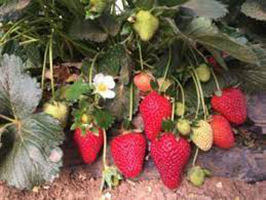Master Gardeners – Strawberries: Home grown will always be sweetest
Published 12:54 am Saturday, January 29, 2022

- Image courtesy of Today.tamu.edu Strawberry plants are cold-hardy plants which do well in our growing environment
|
Getting your Trinity Audio player ready...
|
By John Green
Certified Texas Master Gardner, OC Master Gardner
Hello fellow gardening enthusiasts! We have been lucky this past week experiencing mild seasonal temperatures including a couple nights of below freezing temperatures (barely below). This got me thinking about cold-hardy plants which do well in our growing environment. Strawberry plants came to mind since they are cold hardy and now is the time to plant them. Late January through mid-March is the ideal time to plant this low spreading fruit. They can be planted as early as six weeks before our last frost, which in Southeast Texas is around March 10th.
Spring-bearing strawberry varieties, such as “Chandler”, “Sequoia”, and “Douglas” are better suited to our local climate. It’s best to avoid ever-bearing and day-neutral varieties, as they enjoy cooler temperatures. Growing strawberries is easy but planning and site preparation are the keys to success, so let’s get started! The following information will help you get started growing strawberries. Use the tips listed for growing the best strawberries ever.
Strawberry Growing Tips:
Garden Planning
- Set new plants out in early spring, 4 to 6 weeks before predicted last frost.
- For the best harvest, start a new beds or rows yearly. Remove previous strawberry beds which have fruited.
- Strawberry plants bear fruit their second season.
- It’s best to have at least two strawberry beds.
Site Preparation
- Ensure the planting site provides strawberry plants with a minimum of 8 hours of full sun light. Excellent drainage and good air circulation are also necessary.
- Before planting strawberries, amend the soil with compost, and aged manure if available. Also add a complete fertilizer (5-10-10) using ½ lb. for a 25-foot row.
- Strawberries require acidic soil with a pH between 5.5 and 6.5.
- Do not guess you soils pH, instead contact the Orange County AgriLife Extension office (409) 882-7010 for assistance and more information on capturing soil samples for analysis. Soil analysis results are usually provided quickly and provide necessary to amend soil correctly.
Bareroot Planting
- Space rows 4 feet apart.
- Soak the plants’ roots in water for 30 minutes before planting.
- Trim roots of new plants to approximately 4 to 5 inches in length.
- Place plants 12” to 18” apart in each row.
- Dig each planting hole deep enough to cover the roots but not the plants’ crown.
- Lightly tamp soil against the roots and then add 1 or 2 cups of water mixed with a diluted soluble fertilizer (add one heaping handful of 5-10-10 fertilizer into a 5-gallon bucket and fill with water).
- Planting diagram shows correct root placement at soil level.
Plant Care
- 1st year (Spring): Keep bed free of weeds and remove blossoms to prevent fruiting. This encourages production of healthy daughter plants.
- 5 to 6 weeks after spring planting: Train daughter plants to take root in a 9-by-9-inch spaced row system.
- Late spring into summer: Side-dress with ammonium nitrate (1/8th lb. per 25-foot row), 5-10-10 (3/4th lb. per 25-foot row), or manure tea (1/2 to 1 pint per plant). Side-dress each plant again 1 month later.
- Late fall or winter: Once a few freezes have occurred, mulch with 3” to 5” of pine needles.
- 2nd year, Late spring: Gradually remove mulch, but protect blossoms from late frost with mulch cover as necessary.
- Provide 1 inch of water each week while the fruit is developing until harvest.
- Cover the patch with strawberry netting to keep birds out.
- Summer: Once harvest is complete, remove plants or till the plants into the soil and plant a cover crop, Prepare the bed for new plants next spring.
Harvesting
- Strawberries will ripen about 1 month after the plants bloom. Expect 2 to 3 weeks of harvesting for each variety.
- Pick the plants clean every 2 or 3 days. Avoid the green-tipped berries as they’re not fully ripe.
- When harvesting, don’t leave berry remnants on the plants since this encourages the plant to rot.
For more information or to have all your gardening questions answered, contact the Orange County Master Gardeners: Website: https://txmg.org/orange Facebook: Orange County Texas Master Gardeners Association Helpline: (409) 882-7010 Email: extension@co.orange.tx.us.







